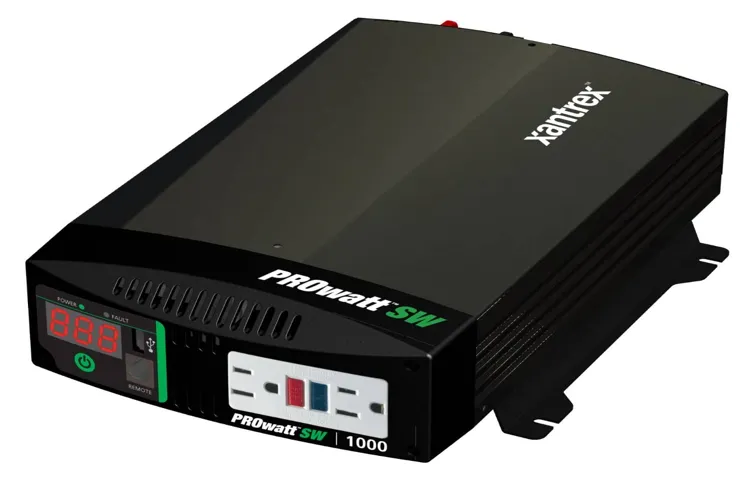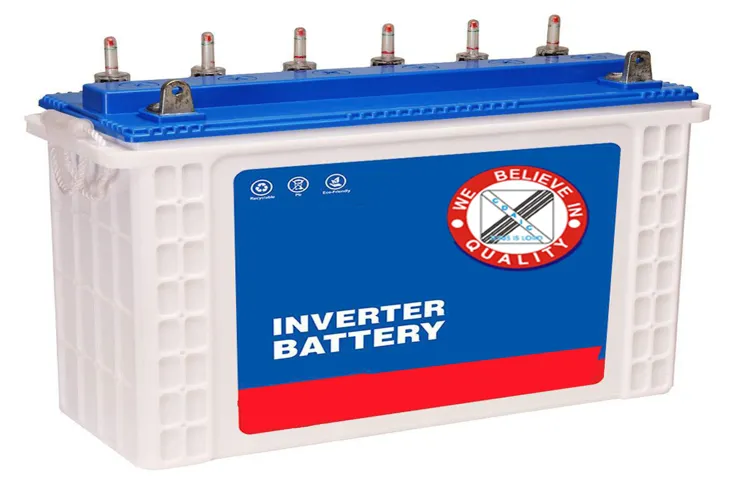Have you ever wondered how inverters work and how they affect power consumption? Inverters are essential components in many modern electronic devices, but their inner workings may seem perplexing at first. In this blog, we will dive into the world of inverters and explore their role in regulating and converting electrical power. We will also shed light on power consumption and how inverters can impact it.
So, let’s embark on this enlightening journey to understand the fascinating world of inverters and power usage. Get ready to unravel the mystery behind this crucial aspect of our everyday lives!
Table of Contents
What is an Inverter?
Have you ever wondered how much power your inverter uses? Well, let’s break it down for you! An inverter is a device that converts direct current (DC) power, often from batteries, into alternating current (AC) power that can be used to power various appliances and devices. When the inverter is not actively converting DC to AC power, it still consumes a small amount of power to keep itself running. This is known as the idle power consumption of the inverter.
The actual amount of power consumed by an inverter when it is idle can vary depending on the specific model and brand, but it is typically in the range of a few watts. This means that even when you are not using any appliances or devices connected to the inverter, it is still using a small amount of power. However, the idle power consumption is relatively low compared to the power consumed when the inverter is actively converting DC to AC power.
So, while it is important to consider the power consumed by your inverter when it is idle, it is even more crucial to understand its power consumption when it is actively in use.
Definition and Purpose
inverter An inverter is a device that converts direct current (DC) into alternating current (AC) electricity. In simpler terms, it takes the power from a battery or a solar panel and converts it into the type of electricity that can be used to power everyday appliances and devices in our homes. The purpose of an inverter is to enable us to use our electrical devices and appliances even when we are not connected to the grid.
Think of an inverter as a translator for electricity. Just like a translator helps us communicate with someone who speaks a different language, an inverter helps us connect our DC power source to our AC power appliances. It takes the energy stored in a battery or generated by a solar panel, which is in the form of DC power, and translates it into AC power that can be used by our devices.
Inverters have become an essential part of our lives, especially when it comes to renewable energy sources like solar power. Solar panels generate DC power, but most of our appliances and devices run on AC power. Without an inverter, we wouldn’t be able to use the clean energy produced by solar panels to power our homes.
So the next time you turn on a light or charge your phone, remember that it’s all thanks to the inverter that makes it possible to convert and use electricity in the most convenient way for us.

Types of Inverters
inverter, types of inverters
How Does an Inverter Work?
One common question many people have about inverters is how much power they actually use. Well, the power consumption of an inverter can vary depending on its size and the amount of load it is supporting. In general, smaller inverters that are used for powering small electronic devices like laptops or cell phones will consume less power compared to larger inverters that are used for running appliances or an entire house.
It’s important to note that inverters themselves consume a small amount of power just to operate, even when no load is being supplied. This power consumption is usually minimal, but it’s worth considering if you’re using the inverter for an extended period of time or if you’re trying to maximize your energy efficiency. So, while inverters do use some power, it’s generally a small amount compared to the power they are providing.
Explanation of Inverter Functionality
An inverter is an essential component that converts direct current (DC) power into alternating current (AC) power. But how exactly does it work? Well, think of it as a translator between two languages. In this case, the DC power generated by sources such as solar panels or batteries is like one language, and the AC power needed to run household appliances or power grids is like another language.
The inverter acts as the translator, taking the DC power and converting it into the AC power that our devices can understand and use. It does this by using electronic components like switches, capacitors, and transformers to reverse the direction of the current, creating the alternating current waveforms that power our homes. So, next time you’re enjoying the convenience of your electronic devices, remember to thank the humble inverter for its role in making it all possible!
Inverter Power Consumption
inverter power consumption
Factors Affecting Inverter Power Consumption
Have you ever wondered how much power your inverter actually uses? Well, there are several factors that can affect the power consumption of your inverter. One of the main factors is the size and capacity of the inverter. Inverters come in different sizes and capacities, and the larger the inverter, the more power it is likely to consume.
Another factor that can affect power consumption is the load that is connected to the inverter. If you are using high-powered appliances or equipment, the inverter will have to work harder and will consume more power. Additionally, the efficiency of the inverter can also play a role in power consumption.
Inverters with higher efficiency ratings will use less power to operate. Finally, the input voltage of the inverter can also affect power consumption. If the input voltage is higher than the required voltage, the inverter will have to work harder and will consume more power.
Overall, it is important to consider these factors when choosing an inverter to ensure that you are getting the most efficient and cost-effective option for your needs.
Load Capacity and Power Demand
load capacity, power demand, inverter power consumption
Efficiency of the Inverter
inverter power consumption The efficiency of an inverter is a crucial factor to consider when it comes to power consumption. Several factors can affect how efficiently an inverter converts DC power to AC power. One of the main factors is the quality of the inverter itself.
Higher-quality inverters tend to have higher efficiency ratings, meaning they convert a larger percentage of the DC power they receive into usable AC power. Another important factor is the load that the inverter is powering. If the load is relatively small compared to the capacity of the inverter, it will operate at a lower efficiency.
On the other hand, if the load is close to the inverter’s maximum capacity, it will operate at a higher efficiency. Additionally, the temperature at which the inverter operates can impact its efficiency. In general, inverters tend to be less efficient at higher temperatures, so it’s important to choose an inverter that is designed to operate in the specific conditions of your installation.
By considering these factors and choosing an inverter with high efficiency, you can reduce your power consumption and maximize the performance of your solar power system.
Battery Voltage
inverter power consumption, battery voltage, factors affecting The voltage of the battery plays a crucial role in determining the power consumption of an inverter. When the battery voltage is low, the inverter has to work harder to convert the DC power from the battery into AC power. This increased workload leads to higher power consumption, which can ultimately drain the battery faster.
On the other hand, when the battery voltage is high, the inverter requires less effort to convert the power, resulting in lower power consumption. It’s like driving a car uphill versus on a flat road – more energy is required to climb the hill, just as more power is needed when the battery voltage is low. So, to optimize the power consumption of an inverter and extend the battery life, it is important to ensure that the battery voltage remains within the recommended range.
This can be achieved by properly maintaining the battery and regularly checking its voltage levels. Additionally, choosing an inverter that is designed to operate efficiently at different battery voltage levels can also help minimize power consumption. In conclusion, the battery voltage is a critical factor affecting inverter power consumption, and keeping it at the right level is essential for efficient operation and increased battery life.
Operating Temperature
operating temperature, inverter power consumption, factors affecting
Measuring Inverter Power Consumption
Have you ever wondered how much power your inverter uses? Well, let’s dive into this fascinating topic and find out! Inverters are devices that convert DC power from sources like batteries or solar panels into AC power that can be used to power household appliances. While inverters are essential for providing electricity in off-grid or backup power situations, they do consume some power themselves. The amount of power an inverter uses can vary depending on factors such as its size, efficiency, and the load it is powering.
Smaller inverters typically have lower power consumption, while larger ones may use more power due to their higher capacity. Additionally, inverters that have a higher efficiency rating will use less power than those with a lower efficiency rating. To determine the power consumption of your inverter, you can check its specifications or use a power meter to measure the electricity it consumes over a period of time.
By understanding how much power your inverter uses, you can make informed decisions about its usage and optimize your overall energy consumption.
Using a Power Meter
power meter, measuring inverter power consumption
Calculating Power Consumption Using Voltage and Current
In order to measure the power consumption of an inverter, we need to understand the relationship between voltage, current, and power. Power consumption is determined by multiplying the voltage and current together. So, if we know the voltage and current of an inverter, we can easily calculate its power consumption.
To measure the voltage, we can use a multimeter. Simply connect the probes of the multimeter to the positive and negative terminals of the inverter and set the multimeter to measure the voltage. The reading on the multimeter will give us the voltage of the inverter.
Measuring the current is a bit trickier. We can use a clamp meter to measure the current flowing through a wire. The clamp meter has a jaw that can be opened and clamped around the wire, allowing it to measure the current without interrupting the circuit.
Once the clamp meter is in place, it will give us the current reading. Now that we have both the voltage and current readings, we can calculate the power consumption using the formula P = V x I, where P is power, V is voltage, and I is current. Simply multiply the voltage and current together to get the power consumption of the inverter.
By measuring the voltage and current of an inverter and using the formula P = V x I, we can calculate its power consumption. This information can be useful in determining the efficiency of the inverter and making adjustments to optimize its performance. So, next time you want to know how much power your inverter is consuming, grab a multimeter and clamp meter and start measuring!
Determining Your Inverter’s Power Consumption
Are you curious about how much power your inverter uses? Well, you’re not alone! Many people wonder about this because it can impact their electricity bills and overall energy consumption. Thankfully, determining your inverter’s power consumption is relatively straightforward. Inverters usually come with a power rating, which indicates how much power they consume while operating.
This rating is typically listed in watts and can vary depending on the size and type of inverter you have. To find out the exact power consumption of your inverter, you can check its manual or look for specifications online. Knowing how much power your inverter uses is essential for making informed decisions about your energy usage and can help you optimize your electricity consumption.
So, next time you’re thinking about energy efficiency, don’t forget to consider your inverter’s power consumption!
Manufacturer Specifications
power consumption, inverter’s power consumption, manufacturer specifications
Load Types and Usage Patterns
Determining Your Inverter’s Power Consumption When it comes to using an inverter, understanding its power consumption is crucial. This will help you determine the load types and usage patterns that are best suited for your specific needs. An inverter converts DC power from a battery into AC power, allowing you to use your electronic devices and appliances even when you’re off the grid.
However, different devices have different power requirements, and it’s important to match the power consumption of your inverter to the devices you plan to use. To determine the power consumption of your inverter, you first need to identify the load types you will be using. Load types refer to the different devices or appliances that you’ll be powering with your inverter.
These can range from basic electronics like laptops and smartphones to more power-hungry appliances like refrigerators or power tools. Each load type will have its own power rating, expressed in watts. Once you have identified the load types, you can calculate the total power consumption by adding up the power ratings of each device you plan to use simultaneously.
This will give you an idea of the maximum power your inverter needs to be able to provide. It’s important to note that some devices, like refrigerators or air conditioners, have a higher power surge when they start up, known as the burstiness. This surge in power needs to be factored in when determining your inverter’s power consumption.
To ensure that your inverter is able to handle the power needs of your devices, it’s recommended to choose an inverter that has a higher power rating than the total power consumption you have calculated. This will provide a safety margin and prevent any overload or overheating issues. Additionally, knowing the usage patterns of your devices is also important.
Are you planning to use them continuously or intermittently? This will affect the overall power consumption and the size of the inverter you will need. In conclusion, determining your inverter’s power consumption is crucial for a successful and efficient off-grid experience. By understanding the load types and usage patterns of your devices, you can confidently choose an inverter with the right power rating to meet your needs.
Measuring Power Consumption
power consumption, inverter, determining
Reducing Inverter Power Consumption
If you’re wondering how much power your inverter uses, you’re not alone. Inverter power consumption can vary depending on a few factors, such as the size and efficiency of the inverter, as well as how much power is being drawn from it. In general, larger inverters will consume more power than smaller ones.
The efficiency of the inverter is also a big factor. Higher efficiency inverters will use less power, which can ultimately save you money on your electricity bill. So, if you’re looking to reduce inverter power consumption, it might be worth considering investing in a more efficient inverter.
Additionally, it’s important to be mindful of how much power you’re drawing from your inverter. Using energy-saving measures, such as turning off unused electronics or appliances, can help reduce the amount of power being drawn from the inverter, ultimately decreasing its power consumption.
Choosing a High-Efficiency Inverter
high-efficiency inverter
Optimizing Load Capacity
When it comes to optimizing the load capacity of your inverter, one important aspect to consider is reducing power consumption. Inverters are essential for converting DC power from batteries or solar panels into AC power that can be used by household appliances. However, they can consume a significant amount of power themselves, leading to inefficiencies and higher electricity bills.
To address this, you can take several measures to minimize power consumption. For instance, choosing an inverter with high efficiency ratings can significantly reduce power losses during the conversion process. Additionally, using power-saving features such as sleep mode or shutting down idle inverters can further optimize energy usage.
By adopting these strategies, you can ensure that your inverter operates efficiently and maximizes its load capacity while minimizing power consumption.
Managing Power Demand
reducing inverter power consumption Inverter power consumption can be a significant contributor to overall energy usage in homes and businesses. But there are steps you can take to reduce this consumption and minimize the impact on your energy bill. One of the most effective strategies is to choose an inverter with a high efficiency rating.
Look for inverters that are labeled as “high efficiency” or have a high efficiency percentage, as this means they will convert a larger portion of the energy they receive into usable power. Another option is to consider using microinverters, which are small inverters that are installed on each individual solar panel. These microinverters can increase the overall efficiency of the system and reduce power losses.
Additionally, you can also reduce inverter power consumption by properly sizing your solar system. By determining the optimal size for your system, you can ensure that your inverter is operating at its peak efficiency and not wasting energy. Finally, make sure to regularly maintain and clean your solar panels and inverters.
Dust, dirt, and debris can hinder the performance of your system and cause it to consume more power. By keeping them clean, you can ensure that your inverter is functioning efficiently and using energy in the most effective way possible. So, by taking these steps to reduce inverter power consumption, you can save energy and lower your electricity bills.
Improving Battery Efficiency
In the quest for improved battery efficiency, reducing inverter power consumption is a crucial step. The inverter is an essential component of any battery system as it converts direct current (DC) from the battery into alternating current (AC) that can be used to power electrical devices. However, the conversion process can result in energy losses and inefficiencies.
By finding ways to minimize the power consumption of the inverter, we can maximize the overall efficiency of the battery system. One approach to achieve this is through the use of advanced power electronics and control algorithms that optimize the operation of the inverter. These technologies can help to reduce the power losses during the conversion process and improve the overall energy conversion efficiency.
Additionally, advancements in semiconductor devices and circuit design can contribute to lower power consumption in inverters. By continuously innovating in these areas, we can strive to create more energy-efficient batteries that offer longer-lasting power and contribute to a more sustainable future.
Conclusion
In conclusion, the power consumption of your inverter is a sly little mystery that likes to dance between dimensions, tantalizing us with its enigmatic ways. Like a master illusionist, it toys with our expectations, bending and flexing its electrical muscles without revealing its true form. But fear not, intrepid reader, for I have donned my detective hat and pieced together the clues hidden within the shadows.
The power usage of your inverter depends on a multitude of factors, from the device’s efficiency to the voltage and current it receives, and even the alignment of the celestial bodies (okay, maybe not the last one). To truly unravel the enigma, one must embark on a quest of knowledge and experiment, measuring the wattage consumed under different scenarios. With careful observation and a sprinkle of scientific deduction, you shall emerge triumphant with an answer that eludes many.
So, my friend, embrace the adventure and let’s unlock the secrets of your inverter’s power consumption together. As we journey through the realms of electrical wizardry, remember that knowledge is power, and it’s up to us to wield that power with wit, cleverness, and perhaps a touch of magic. Happy exploring!”
FAQs
How much power does my inverter use when it is idle?
When your inverter is idle, it typically consumes a small amount of power ranging from 1 to 10 watts. This power is used to operate the internal electronics and maintain standby functionality.
Does the power consumption of my inverter depend on its size?
Yes, the power consumption of an inverter can vary depending on its size or capacity. Generally, larger inverters tend to consume more power when idle compared to smaller ones.
How can I calculate the power consumption of my inverter during operation?
To calculate the power consumption of your inverter during operation, you need to multiply the output load in watts by the inverter’s efficiency. For example, if the load is 500 watts and the inverter efficiency is 90%, the inverter will consume approximately 556 watts (500 ÷ 0.9) of power.
Can I reduce the power consumption of my inverter?
Yes, you can reduce the power consumption of your inverter by turning it off when not in use or by using power-saving features if available. Additionally, choosing an inverter with higher efficiency can also help reduce power consumption.
Will running my inverter at maximum capacity increase its power consumption?
Running your inverter at maximum capacity may slightly increase its power consumption, as it needs to work harder to deliver the required amount of power. However, the difference in power consumption between operating at maximum capacity and a lower load is generally minimal.
Are there any factors that can affect the power consumption of an inverter?
Yes, there are several factors that can affect the power consumption of an inverter, including the type of load being powered, the efficiency of the inverter, and the operating conditions such as temperature and voltage fluctuations.
Can the power consumption of an inverter vary between different models or brands?
Yes, the power consumption of an inverter can vary between different models and brands. Some inverters are designed with energy-saving features and improved efficiency, which can result in lower power consumption compared to other models. It’s important to consider these factors when choosing an inverter.



